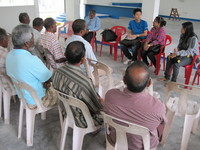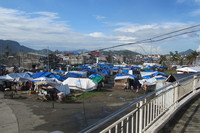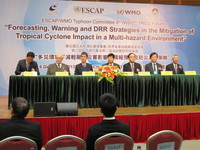23 - 29 December 2013, Maldives
 Since 2009, ADRC has initiated a pilot project of DRR Policy Peer Review with the aim of developing DRR capacity of ADRC member countries by sharing information and strengthening the relationship among member countries.
Since 2009, ADRC has initiated a pilot project of DRR Policy Peer Review with the aim of developing DRR capacity of ADRC member countries by sharing information and strengthening the relationship among member countries.
This year, "Developing a National Framework on Managing Internally Displaced Populations (IDPs) during emergencies" was selected as one of the target projects of the fifth year. After the submission of country report, reviewer team composed of Ph.D. Anawat Suppasri (Associate Professor, International Research Institute of Disaster Science, Tohoku University, Japan), Ms. Nwet Yin Aye (Deputy Director, The Ministry of Social Welfare, Relief and Resettlement, Myanmar) and Mr. Junji Moriwaki (Researcher of ADRC) had visited Maldives to conduct interview surveys.
The team visited relevant organizations involving in DRR activities to examine how they have been making efforts of developing DRR in Maldives. Then, the team conducted inspection and interview at 2004 Indian Ocean Earthquake and Tsunami affected area, and prepared a draft report of the survey result with all findings and recommendations (such as the development of DRR at community level, through capability and legislation building). Also the workshop was held in Male for getting opinion and comments to finalize the report, as well as introducing good practices for reducing tsunami risk and IDPs management activities in Japan and Myanmar. It provided a very good opportunity for exchanging opinions each other.
This project aims at developing the mutual learning process among ADRC member countries instead of one-way learning. After the survey missions, reviewer team will compile survey reports and send them to target countries and then to ADRC member countries to enhance cross-fertilization.
ADRC would like to express its sincerest gratitude to all of those who have made precious contribution to this project.
(2013/12/23 19:40)



